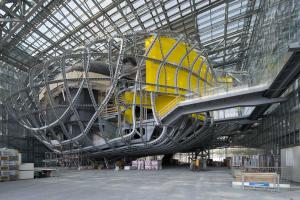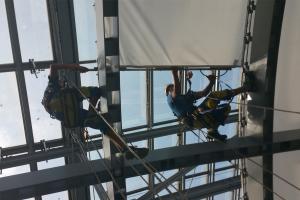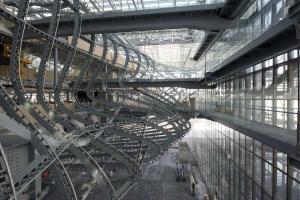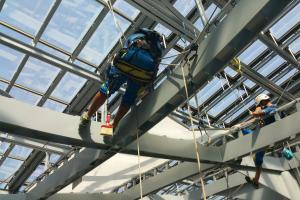Rome Convention Center
|
These are the words of Achille Bonito Oliva, art critic and academic, during a lectio magistralis held at Rome's La Sapienza University with Massimiliano Fuksas, the designer of the Rome Convention Center La Nuvola”. “This project comes from a reflection that started in the 'Nineties: the Atlantic crossings I was doing every fortnight gave me a sense of this new relationship between being above the clouds and beneath the clouds. What we have done here is an attempt at creating a geometry that starts from nature, and is complex but at the same time achievable.” This is how Massimiliano Fuksas himself summarises the principles that inspired him, in an interview given in "La Storia Siamo Noi", the program presented by the journalist Giovanni Minoli and broadcast by RAI. “The idea behind the project was to create a sort of glass display case, containing an object with absolutely no clearly defined elementary, or euclidean, geometry. What were of greatest interest were the interstitial spaces, that is to say the ones between the parts of the show case that are compressed by the so-called Cloud.” |
 |
||
 |
 |
 |
|
|
The Rome Convention Center - La Nuvola is Rome's new conference centre, which opened its doors to the world market for conferences and large events from 29 October of last year. A solid opportunity for growth of the city's economy, in the highest value tourism sector. |
|||
 The structure, which is able to host events of the most varying types, from conventions to exhibitions, from shows to performances and naturally conferences, can briefly be divided into 3 elements: the "Teca" (Box), the "Nuvola" (Cloud) and the "Lama" (Blade). The structure, which is able to host events of the most varying types, from conventions to exhibitions, from shows to performances and naturally conferences, can briefly be divided into 3 elements: the "Teca" (Box), the "Nuvola" (Cloud) and the "Lama" (Blade).The Teca is a “box” shape (40 metres high, 70 m wide and 175 m long), with a steel structure and double glass façade, and is in effect the container that houses the "Nuvola" within it.
The Nuvola, with its steel rib structure coated with a special material that we will look at later, is the fulcrum, the architectural element that characterises the project. It is this comparison between a free spatial element, without rules - the Nuvola - and a clearly defined geometric form, like the shape of the Teca, capable of creating an extraordinary visual effect, that is amplified at sunset by extraordinary artistic lighting. Then there is the Lama, the building (126 m x 15 x 55) that houses a hotel with 439 rooms, intended to be an independent and separate structure and designed, like the rest of the complex, by Massimiliano Fuksas. CONFERENCE HALLS
In the underground level of the complex, as well as one of the parking areas for 600 cars, there is the large space dedicated to the "conference halls": 9,000 m2 that can be variously configured in a modular manner, thanks to a mobile wall system, that can house up to 6,000 people in a single full session. To give an idea of the flexibility, let us consider two examples of different configurations: it is possible to have a configuration with 5,000 seats in a single main room (7,400 m2) with 1,500 m2 of foyer and 4 meeting rooms with 100 seats; or a configuration with 3,000 seats in a single main room (3,350 m2) plus additional, smaller rooms, that can be divided into modules to give a maximum of 24 rooms. In 2018 this space, which has already hosted its first events, will be used to host the world conference of the IBA, International Bar Association, the first big international event that has been awarded to Rome, beating well-known conference venues such as Boston and St. Petersburg, which will bring 6,000 lawyers from all over the world to Rome. Moving to the right, there is a space known as the Concourse. CONCOURSE
Remaining on the same floor, at level -1, there is a functional area of 2,500 m2, the "concourse", that is of great importance, as it includes numerous service points such as cloakroom areas and some of the 200 bathrooms present, while at "mezzanine level" it also houses business centres (offices), reception areas, translation booths, control room, speakers and hospitality areas. Above, over your heads, you can clearly see some of the 2,000 lights created by an Italian company, which feature the ability to provide double lighting from a single lighting element, on the ground and on the ceiling. Returning to the space known as the "conference halls", using one of the 9 moving staircases present, rather than a glass lift, we go up to the floor above. FORUM |
|||

